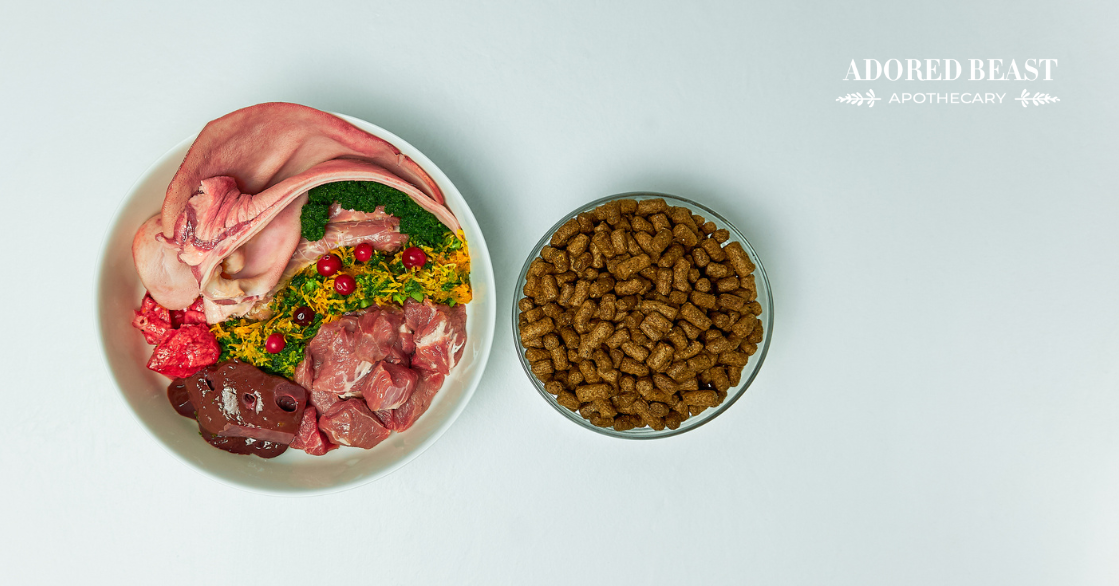Over the last few years, many, many pet parents have chosen to make the move from kibble to raw dog food. Many more vets are accepting (even encouraging), there are many commercial options, and there’s a wealth of information available on the internet.
But even with all of this acceptance and acknowledgement, we know that the transition to raw can seem scary and overwhelming – especially if you don’t know exactly how to do it.
Whether you’re considering the move to address a current health concern, or just want to do it for overall health and longevity, we’re here to help with 2 simple approaches to make the move easy. We’ll also cover things you may notice, and additional ways to support your animal throughout the process.
How to Move to Raw Dog Food
Ok, so you’ve done your homework. You’ve chosen a well-balanced commercial food or decided to make your own based on a nutritionally balanced recipe created by an expert.
Now what?
All animals are different. Some dogs like a gradual transition, while others take to raw like they’ve never eaten anything else. So, we’re giving you two approaches to transition to raw dog food.
Approach #1: The Gradual Transition
With this approach, you take things slow and steady. Over the course of several days, you slowly replace a portion of your dog’s current diet with raw.
Then, as time progresses, you replace more of the original diet with raw.
Here’s what it looks like:
- Day 1 & 2– 25% raw, 75% original diet
- Day 3 & 4 – 50% raw, 50% original diet
- Day 5 & 6 – 75% raw, 25% original diet
- Day 7 & on– 100% raw
You can feed the different foods separately or mix them together. There is no harm in feeding them together. Some dogs will like the mix as it’s not too much change at once.
We like this approach for dogs who are picky, for older dogs who’ve eaten kibble their entire lives, or for dogs who typically have sensitive tummies. It can also be helpful for pet parents who are a bit more nervous about the switch (but remember, there’s nothing to be nervous about).
**This breakdown is for 7 days, but you can make it 14 if that works for you, or even shorten it if you think it’s going really well!
Approach #2: The Cold Turkey Transition
This one is pretty straight-froward. One meal is completely the original diet, and the next is completely raw. There’s no mixing, there’s no gradual transition. It’s just one meal to the next. It’s quitting the original diet cold turkey.
This is the method we took with both Inuk (when she was 7) and Indi (when she was 9 weeks). Both girls did amazing.
Remember: your dog is an individual, and the approach you take is what fits you both best. If you try the “cold turkey” approach and your dog isn’t a huge fan, switch to a more gradual transition and do it over time.
Also, we recommend buying or making the food in small batches at first. Sometimes dogs will turn their noses up at one brand/recipe, but scarf down another with no issues. Don’t be discouraged if your dog isn’t a fan of the first option you present to them. You can always try a different blend. Be patient with your pup.
Things You Might Notice As You Switch
Whether you move to raw dog food gradually or all at once, there are a few things you might notice.
- You might notice loose poops. Some dogs will have looser stools than usual for a day or two. This is because the enzymes required to break down raw vs kibble are different and the digestive system just needs a little time to get used to the change. Digestive enzymes may be good here as they’ll help with the absorption of nutrients.
- You might notice smaller, firmer poops. This is one of the benefits of raw for pet parents specifically! And it’s what you want. Smaller poops mean your dog is absorbing and using more of the food! (They’ll also break down faster. Bonus!)
- Your dog might seem hungry. If your dog currently eats kibble, the feeling after eating raw will be different. Most kibble expands in the stomach, creating that “full” feeling, whereas raw won’t do that because it’s nutrient-dense with lots of moisture (and few – if any – expanding carbs). This is normal, and your dog will adjust.
- You might notice some gas or digestive upset. Again, this is normal. Because raw food is so different from kibble, the body may need time to adjust. Probiotics can help to balance out the bacteria in the gut, replenishing the friendly bacteria, which may help the body adjust more quickly. Have Gut Soothe on hand.
- Your dog is really, really excited for meal time. This is just because raw food is so darn tasty! Get used to it.
Making the move from kibble to raw dog food can be really good for your animal. Whether you take a more gradual approach, or transition fully from one meal to the next, the end result will be a healthy, happy pup. Don’t put pressure on yourself or your animal. Make it a fun experience and enjoy the benefits.












